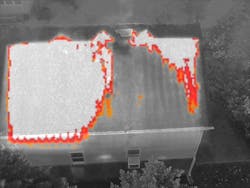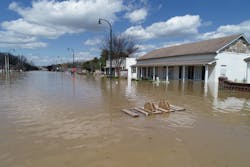On March 28, 2021, during a deadly flash flooding event in middle Tennessee, despite warnings, a man went kayaking on the Harpeth River in Franklin, TN. Shortly thereafter, a motorist spotted the man from an overpass and called 9-1-1, reporting that the man’s kayak capsized and that he appeared to be in distress. The Franklin Fire Department (FFD) was dispatched to rescue him.
What made this search and rescue operation unique for the department was the way that FFD members located the victim—with the assistance of a drone. In less than 15 minutes, FFD’s drone team (Capt. Clay Mackey and Firefighter/Paramedic Daniel Donegan) spotted the victim by using a drone that had a thermal sensor. The victim was clinging, unharmed, to trees, which were surrounded by floodwaters.
The drone enabled just two department members to search a large area without having to place personnel in the water. In fact, crews didn’t enter the water until they knew the victim’s precise location. Once the victim was found, the drone allowed the drone team to visually monitor the victim and the rescue operation, which added a layer of safety to the incident. If any part of the rescue went wrong, the team would have been able to redirect further resources immediately.
In the past year, the FFD increasingly used drones during a variety of incidents, special events and geographic information system (GIS) projects.
The FFD, which has eight stations and 150 personnel, purchased its first drone in 2018 for $1,500. It couldn’t be flown because of the city’s drone policy, which was restrictive, and the fact that the department lacked licensed drone pilots.
Deputy Chief Andy King, Mackey and Donegan, who serve in administration and oversee technology solutions for the department, sought to remedy that. It was a slow process: Generally, working to change standard operating procedures is.
The three members worked with the city’s legal department to develop a policy that allows for quick response in emergency situations and public safety operations. The new policy also required board approval. Then, Donegan obtained his Remote Pilot Certificate from the Federal Aviation Administration in July of 2020. Donegan took approximately one month to prepare for the self-study course and exam.
Because Mackey and Donegan aren’t on-shift, they self-dispatch or respond when called by an incident commander. They began responding to various incidents in 2020, including a crane collapse, a commercial structure fire at a 250,000-sq.-ft. warehouse building and residential structure fires.
The team quickly found that drones offer many advantages over the traditional scene size-up. One is providing a rapid overhead view that can be transmitted directly to incident command.
A nighttime train trestle rescue of two teenagers in August 2020 made the department realize that it needed a drone for low-visibility situations. So, within just a few months of implementing its drone program, the FFD purchased two drones that have thermal cameras, lights and speakers, which brought the department’s total fleet of drones to three.
Each of the department’s drones has a purpose and is utilized uniquely.
The DJI Phantom 4 V.2 has been invaluable in conducting thorough damage-assessment surveys following severe weather events, including flooding. The overhead imagery is compatible with the software that the city’s GIS team uses (Esri) and can be added as a layer in that team’s mapping system.
The DJI Mavic Enterprise Dual and DJI Mavic Enterprise Advanced are the department’s main go-to drones when it comes to incident response. They are quick out-of-the-box and into-the-air drones that offer visual and thermal cameras. They have the capability to quickly illuminate a scene at night and to deliver one-way communication to a victim or subject.
In 2021, the department used the newer models in its fleet during a February winter and ice storm in response to a large metal barn collapse that trapped four horses. The drones were used to monitor for structural defects and life-safety concerns for the firefighters who worked below.
In May, the FFD assisted law enforcement personnel with a nighttime search of a rooftop for a burglary suspect.
Finally, the drones have been useful for special events, including sweeping a field after a pyrotechnic show.
Drones have benefitted the Franklin Fire Department in ways that its members never imagined, and the department will continue to leverage them even more.
About the Author
Glenn Johnson
GLENN JOHNSON is the fire chief of the Franklin, TN, Fire Department. A 27-year veteran of the department, previously he served as assistant fire chief of the Operations Division and was responsible for the daily operations of more than 150 firefighters at eight stations, overseeing fire suppression, special operations, emergency medical services and training. Before that, Johnson worked his way through the ranks, being promoted from firefighter to lieutenant, captain, battalion chief of training and deputy chief. A Desert Storm veteran, he began his firefighting career in 1990 while serving in the U.S. Air Force. Johnson has chaired Tennessee’s Homeland Security District 5 Training and Exercise Committee since 2009 and was deployed as a member of the Middle Tennessee Incident Management Team to numerous hurricanes and the 2016 Gatlinburg wildfires. With his expertise in these areas, he was instrumental in helping the city of Franklin to achieve National Incident Management System compliance. Among other honors and accomplishments, in 2018, Johnson received the Tennessee Department of Safety & Homeland Security’s First Responder Award, which is presented to emergency responders for outstanding and heroic actions while serving the people of Tennessee. He has numerous national and state firefighting, emergency medical and emergency management certifications as well as an associate degree in fire science from Volunteer State Community College.



